Characteristics of Spatial–Temporal Evolution of Carbon Emissions from Land Use and Analysis of Influencing Factors in Hubao-Eyu Urban Agglomerations, China
Abstract
:1. Introduction
2. Research Methods and Data
2.1. Overview of the Study Area
2.2. Data Sources
2.3. Research Methods
2.3.1. Estimation of Land Use Carbon Emissions
2.3.2. Land Use Transfer Matrix and Carbon Emission Transfer Matrix Construction
- (1)
- Land use transfer matrix
- (2)
- Land use change dynamics
- (3)
- Land use carbon emissions transfer
2.3.3. Center of Gravity–Standard Deviation Elliptic
2.3.4. Carbon Balance Analysis
- (1)
- Economy contributive coefficient
- (2)
- Ecological support coefficient
2.3.5. Decomposition of Land Use Carbon Emission Factors Based on the LMDI Method
3. Results
3.1. Changes in the Spatial and Temporal Land Use Patterns
3.2. Characteristics of Spatial and Temporal Evolution of Carbon Emissions in Association with Land Use
3.2.1. Analysis of Land Use Carbon Emissions from Different Land Use Types
3.2.2. Land Use Carbon Transfer
3.2.3. Temporal Changes to Land Use Carbon Emissions and Absorption
3.2.4. The Spatial Evolution of Carbon Emissions
- (1)
- Spatial distribution characteristics
- (2)
- Standard deviational ellipse and gravity shift analysis of carbon emissions
3.3. Changes in the Pattern of Land Use Carbon Balance
3.3.1. Spatial Distribution of Economy Contributive Coefficient
3.3.2. Spatial Distribution of Ecological Support Coefficients
3.4. Factor Decomposition of Land Use Related Carbon Emissions
3.4.1. Analysis of the Overall Carbon Emission Driving Factors in the Hubao-Eyu Urban Agglomeration
3.4.2. Analysis of Carbon Emission Drivers by District and County
4. Discussion
5. Conclusions
Author Contributions
Funding
Institutional Review Board Statement
Informed Consent Statement
Data Availability Statement
Conflicts of Interest
References
- Chuai, X.; Huang, X.; Wang, W.; Zhao, R.; Zhang, M.; Wu, C. Land use, total carbon emissions change and low carbon land management in Coastal Jiangsu, China. J. Clean. Prod. 2015, 103, 77–86. [Google Scholar] [CrossRef]
- IPCC. Climate Change 2023 Synthesis Report. 2023. Available online: https://www.ipcc.ch/report/ar6/syr/downloads/report/IPCC_AR6_SYR_LongerReport (accessed on 28 August 2024).
- Li, L.; Huang, X.; Yang, H. Optimizing land use patterns to improve the contribution of land use planning to carbon neutrality target. Land Use Policy 2023, 135, 106959. [Google Scholar] [CrossRef]
- Liu, C.; Xu, R.; Xu, K.; Lin, Y.; Cao, Y. Carbon Emission Effects of Land Use in Chaobai River Region of Beijing–Tianjin–Hebei, China. Land 2023, 12, 1168. [Google Scholar] [CrossRef]
- Yang, F.; He, F.; Li, S.; Li, M.; Wu, P. A new estimation of carbon emissions from land use and land cover change in China over the past 300 years. Sci. Total Environ. 2023, 863, 160963. [Google Scholar] [CrossRef] [PubMed]
- Cui, Y.; Li, L.; Chen, L.; Zhang, Y.; Cheng, L.; Zhou, X.; Yang, X. Land-Use Carbon Emissions Estimation for the Yangtze River Delta Urban Agglomeration Using 1994–2016 Landsat Image Data. Remote. Sens. 2018, 10, 1334. [Google Scholar] [CrossRef]
- Zhang, Y.; Lin, W.; Ren, E.; Yu, Y. Evaluation of spatial distribution of carbon emissions from land use and environmental parameters: A case study in the Yangtze River Delta demonstration zone. Ecol. Indic. 2024, 158, 111496. [Google Scholar] [CrossRef]
- Zhang, C.Y.; Zhao, L.; Zhang, H.; Chen, M.N.; Fang, R.Y.; Yao, Y.; Wang, Q. Spatial-temporal characteristics of carbon emissions from land use change in Yellow River Delta region, China. Ecol. Indic. 2022, 136, 108623. [Google Scholar] [CrossRef]
- Rossi, F.S.; La Scala, N.; Capristo-Silva, G.F.; Della-Silva, J.L.; Teodoro, L.P.R.; Almeida, G.; Tiago, A.V.; Teodoro, P.E.; da Silva Junior, C.A. Implications of CO2 emissions on the main land and forest uses in the Brazilian Amazon. Environ. Res. 2023, 227, 115729. [Google Scholar] [CrossRef]
- Hung, L.Q.; Asaeda, T.; Thao, V.T.P. Carbon emissions in the field of land use, land use change, and forestry in the Vietnam mainland. Wetl. Ecol. Manag. 2021, 29, 315–329. [Google Scholar] [CrossRef]
- Rajbanshi, J.; Das, S. Changes in carbon stocks and its economic valuation under a changing land use pattern—A multitemporal study in Konar catchment, India. Land Degrad. Dev. 2021, 32, 3573–3587. [Google Scholar] [CrossRef]
- Zheng, S.; Huang, Y.; Sun, Y. Effects of urban form on carbon emissions in china: Implications for low-carbon urban planning. Land 2022, 11, 1343. [Google Scholar] [CrossRef]
- Kondo, M.; Ichii, K.; Patra, P.K.; Canadell, J.G.; Poulter, B.; Sitch, S.; Rödenbeck, C. Land use change and El Niño-Southern Oscillation drive decadal carbon balance shifts in Southeast Asia. Nat. Commun. 2018, 9, 1154. [Google Scholar] [CrossRef] [PubMed]
- Zhao, Y.; Ma, S.; Fan, J.; Cai, Y. Examining the effects of land use on carbon emissions: Evidence from Pearl River Delta. Int. J. Environ. Res. Public Health 2021, 18, 3623. [Google Scholar] [CrossRef] [PubMed]
- Tang, W.; Cui, L.; Zheng, S.; Hu, W. Multi-scenario simulation of land use carbon emissions from energy consumption in Shenzhen, China. Land 2022, 11, 1673. [Google Scholar] [CrossRef]
- Wei, B.; Kasimu, A.; Reheman, R.; Zhang, X.; Zhao, Y.; Aizizi, Y.; Liang, H. Spatiotemporal characteristics and prediction of carbon emissions/absorption from land use change in the urban agglomeration on the northern slope of the Tianshan Mountains. Ecol. Indic. 2023, 151, 110329. [Google Scholar] [CrossRef]
- Xia, C.; Zhang, J.; Zhao, J.; Xue, F.; Li, Q.; Fang, K.; Zhou, J. Exploring potential of urban land-use management on carbon emissions—A case of Hangzhou, China. Ecol. Indic. 2023, 146, 109902. [Google Scholar] [CrossRef]
- Yuan, Y.; Chuai, X.; Xiang, C.; Gao, R. Carbon emissions from land use in Jiangsu, China, and analysis of the regional interactions. Environ. Sci. Pollut. Res. 2022, 29, 44540. [Google Scholar] [CrossRef]
- Feng, Y.; Chen, S.; Tong, X.; Lei, Z.; Gao, C.; Wang, J. Modeling changes in China’s 2000–2030 carbon stock caused by land use change. J. Clean Prod. 2020, 252, 119659. [Google Scholar] [CrossRef]
- Meng, Q.; Zheng, Y.; Liu, Q.; Li, B.; Wei, H. Analysis of spatiotemporal variation and influencing factors of land-use carbon emissions in nine provinces of the yellow river basin based on the LMDI model. Land 2023, 12, 437. [Google Scholar] [CrossRef]
- Cui, X.; Wei, X.; Liu, W.; Zhang, F.; Li, Z. Spatial and temporal analysis of carbon sources and sinks through land use/cover changes in the Beijing-Tianjin-Hebei urban agglomeration region. Phys. Chem. Earth. Parts A/B/C 2019, 110, 61–70. [Google Scholar] [CrossRef]
- Wang, C.; Zhan, J.; Zhang, F.; Liu, W.; Twumasi-Ankrah, M.J. Analysis of urban carbon balance based on land use dynamics in the Beijing-Tianjin-Hebei region, China. J. Clean. Prod. 2021, 281, 125138. [Google Scholar] [CrossRef]
- Zhou, Y.; Chen, M.; Tang, Z.; Mei, Z. Urbanization, land use change, and carbon emissions: Quantitative assessments for city-level carbon emissions in Beijing-Tianjin-Hebei region. Sust. Cities Soc. 2021, 66, 102701. [Google Scholar] [CrossRef]
- Xu, Q.; Yang, R.; Dong, Y.X.; Liu, Y.X.; Qiu, L.R. The influence of rapid urbanization and land use changes on terrestrial carbon sources/sinks in Guangzhou, China. Ecol. Indic. 2016, 70, 304–316. [Google Scholar] [CrossRef]
- Guo, B.; Wu, H.; Pei, L.; Zhu, X.; Zhang, D.; Wang, Y.; Luo, P. Study on the spatiotemporal dynamic of ground-level ozone concentrations on multiple scales across China during the blue sky protection campaign. Environ. Int. 2022, 170, 107606. [Google Scholar] [CrossRef]
- Li, J.; Sun, Z.; Zhou, J.; Sow, Y.; Cui, X.; Chen, H.; Shen, Q. The impact of the digital economy on carbon emissions from cultivated land use. Land 2023, 12, 665. [Google Scholar] [CrossRef]
- Chen, Y.; Lu, H.; Li, J.; Xia, J. Effects of land use cover change on carbon emissions and ecosystem services in Chengyu urban agglomeration, China. Stoch. Environ. Res. Risk Assess. 2020, 34, 1197–1215. [Google Scholar] [CrossRef]
- Li, L.; Li, J.; Peng, L.; Wang, X.; Sun, S. Spatiotemporal evolution and influencing factors of land-use emissions in the Guangdong-Hong Kong-Macao Greater Bay Area using integrated nighttime light datasets. Sci. Total Environ. 2023, 893, 164723. [Google Scholar] [CrossRef] [PubMed]
- Fu, B.; Wu, M.; Che, Y.; Yang, K. Effects of land-use changes on city-level net carbon emissions based on a coupled model. Carbon Manag. 2017, 8, 245–262. [Google Scholar] [CrossRef]
- Jain, A.K.; Meiyappan, P.; Song, Y.; House, J.I. CO2 emissions from land-use change affected more by nitrogen cycle, than by the choice of land-cover data. Glob. Chang. Biol. 2013, 19, 2893–2906. [Google Scholar] [CrossRef]
- Fu, W.; Yang, S.; Hu, S.; Zhang, P. The impact of embodied land flow in interregional trade on carbon emissions in China. Appl. Geogr. 2023, 159, 103065. [Google Scholar] [CrossRef]
- Zhou, D.; Huang, Q.; Chong, Z. Analysis on the effect and mechanism of land misallocation on carbon emissions efficiency: Evidence from China. Land Use Policy 2022, 121, 106336. [Google Scholar] [CrossRef]
- Luo, H.; Li, Y.; Gao, X.; Meng, X.; Yang, X.; Yan, J. Carbon emission prediction model of prefecture-level administrative region: A land-use-based case study of Xi’an city, China. Appl. Energy 2023, 348, 121488. [Google Scholar] [CrossRef]
- Wu, S.; Hu, S.; Frazier, A.E. Spatiotemporal variation and driving factors of carbon emissions in three industrial land spaces in China from 1997 to 2016. Technol. Forecast. Soc. Chang. 2021, 169, 120837. [Google Scholar] [CrossRef]
- Yu, Z.; Lu, C.; Tian, H.; Canadell, J.G. Largely underestimated carbon emission from land use and land cover change in the conterminous United States. Glob. Chang. Biol. 2019, 25, 3741–3752. [Google Scholar] [CrossRef] [PubMed]
- Cai, C.; Fan, M.; Yao, J.; Zhou, L.; Wang, Y.; Liang, X.; Chen, S. Spatial-temporal characteristics of carbon emissions corrected by socio-economic driving factors under land use changes in Sichuan Province, southwestern China. Ecol. Inform. 2023, 77, 102164. [Google Scholar] [CrossRef]
- Kang, T.; Wang, H.; He, Z.; Liu, Z.; Ren, Y.; Zhao, P. The effects of urban land use on energy-related CO2 emissions in China. Sci. Total Environ. 2023, 870, 161873. [Google Scholar] [CrossRef]
- Gui, D.; He, H.; Liu, C.; Han, S. Spatio-temporal dynamic evolution of carbon emissions from land use change in Guangdong Province, China, 2000–2020. Ecol. Indic. 2023, 156, 111131. [Google Scholar] [CrossRef]
- Jones, C.D.; Ciais, P.; Davis, S.J.; Friedlingstein, P.; Gasser, T.; Peters, G.P.; Rogelj, J.; van Vuuren, D.P.; Canadell, J.G.; Cowie, A.; et al. Simulating the Earth system response to negative emissions. Environ. Res. Lett. 2016, 11, 095012. [Google Scholar] [CrossRef]
- Wang, X.; Zhao, X.; Zhang, S.; Shi, S.; Zhang, X. Decoupling Effect and Driving Factors of Land-Use Carbon Emissions in the Yellow River Basin Using Remote Sensing Data. Remote Sens. 2023, 15, 4446. [Google Scholar] [CrossRef]
- Dunn, J.B.; Mueller, S.; Kwon, H.Y.; Wang, M.Q. Land-use change and greenhouse gas emissions from corn and cellulosic ethanol. Biotechnol. Biofuels 2013, 6, 1–13. [Google Scholar] [CrossRef]
- Gong, J.; Shi, J.; Zhu, C.; Li, X.; Zhang, Z.; Zhang, W.; Hu, Y. Accounting for land use in an analysis of the spatial and temporal characteristics of ecosystem services supply and demand in a desert steppe of Inner Mongolia, China. Ecol. Indic. 2022, 144, 109567. [Google Scholar] [CrossRef]
- Yang, X.; Liu, X. Path analysis and mediating effects of influencing factors of land use carbon emissions in Chang-Zhu-Tan urban agglomeration. Technol. Forecast. Soc. Chang. 2023, 188, 122268. [Google Scholar] [CrossRef]
- Zhao, L.; Chen, M.-N.; Yang, C.-H.; Zhang, R.-Z.; Zhang, Q.-P.; Wang, Q. Characteristics of spatial and temporal carbon emissions from different land uses in Shanxi section of the Yellow River, China. Environ. Dev. Sustain. 2024, 26, 20869–20884. [Google Scholar] [CrossRef]
- Xia, J.; Wang, J.; Lai, Y. Development Strategy Based on Combination Typologies of Building Carbon Emissions and Urban Vibrancy—A Multi-Sourced Data-Driven Approach in Beijing, China. Land 2024, 13, 1062. [Google Scholar] [CrossRef]
- Zhang, W.; Wang, M.Y. Spatial-temporal characteristics and determinants of land urbanization quality in China: Evidence from 285 prefecture-level cities. Sustain. Cities Soc. 2018, 38, 70–79. [Google Scholar] [CrossRef]
- Simmons, C.T.; Matthews, H.D. Assessing the implications of human land-use change for the transient climate response to cumulative carbon emissions. Environ. Res. Lett. 2016, 11, 035001. [Google Scholar] [CrossRef]
- Pan, L.; Yu, J.; Lin, L. The temporal and spatial pattern evolution of land-use carbon emissions in China coastal regions and its response to green economic development. Front. Environ. Sci. 2022, 10, 1018372. [Google Scholar] [CrossRef]
- Cai, Y.; Li, K. Spatiotemporal dynamic evolution and influencing factors of land use carbon emissions: Evidence from Jiangsu Province, China. Front. Environ. Sci. 2024, 12, 1368205. [Google Scholar] [CrossRef]
- Xiong, C.; Yang, D.; Huo, J. Spatial-temporal characteristics and LMDI-based impact factor decomposition of agricultural carbon emissions in Hotan Prefecture, China. Sustainability 2016, 8, 262. [Google Scholar] [CrossRef]
- Chen, L.; Hang, Y.; Li, Q. Spatial-temporal characteristics and influencing factors of carbon emissions from land use and land cover in black soil region of Northeast China based on LMDI simulation. Sustainability 2023, 15, 9334. [Google Scholar] [CrossRef]
- Han, Y.; Ge, X. Spatial–Temporal Characteristics and Influencing Factors on Carbon Emissions from Land Use in Suzhou, the World’s Largest Industrial City in China. Sustainability 2023, 15, 13306. [Google Scholar] [CrossRef]
- Zhou, H.; Liu, Y.; Wang, C.; Yao, S.; Miao, Y.; Yu, S. Spatial Relationship between Land Use Efficiency and land expansion in China’s provincial cities: Based on the theory of Smart Growth. Areal Res. Dev. 2021, 40, 157–162. [Google Scholar]
- Kong, F.; Liu, X.; Zhou, H.; He, Q. Spatio-temporal evolution characteristics and influencing factors of the coupling coordination between new infrastructure construction and urban green development. Econ. Geogr. 2022, 42, 22–32. [Google Scholar]
- Wang, Q.; Xiao, Y. Has Urban Construction Land Achieved Low-Carbon Sustainable Development? A Case Study of North China Plain, China. Sustainability 2022, 14, 9434. [Google Scholar] [CrossRef]
- Zhang, R.; Zhang, X.; Yin, P. Spatial-temporal differentiation and driving factors identification of urban land resources carrying capacity in the Yangtze River Economic Belt. Econ. Geogr. 2022, 42, 185–192. [Google Scholar]
- Liu, Q.; Wang, H.; Wang, W.; Zhang, X.; Zhao, W.; Jia, Y. Establishment of environment and economic development quality assessment system and coupling coordination degree analysis in Sichuan Province. Environ. Protect. Sci. 2022, 48, 39–45. [Google Scholar]
- Sun, J.; Xue, Q. Has technological innovation improved the efficiency of carbon emissions? Ecol. Econ. 2022, 38, 22–28, 34. [Google Scholar]
- Zhu, E.; Deng, J.; Zhou, M.; Gan, M.; Jiang, R.; Wang, K.; Shahtahmassebi, A. Carbon emissions induced by land-use and land-cover change from 1970 to 2010 in Zhejiang, China. Sci. Total Environ. 2019, 646, 930–939. [Google Scholar] [CrossRef]
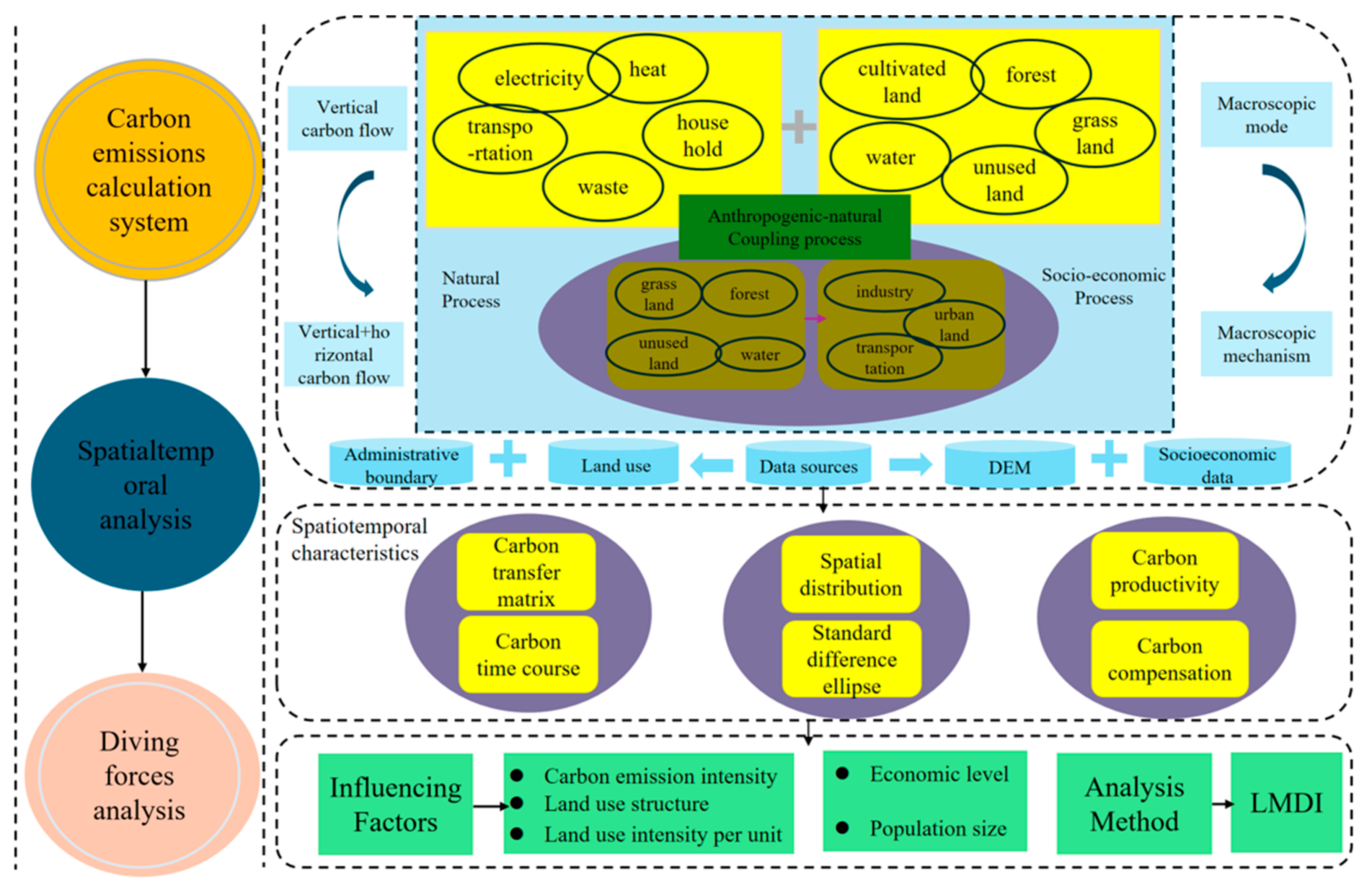
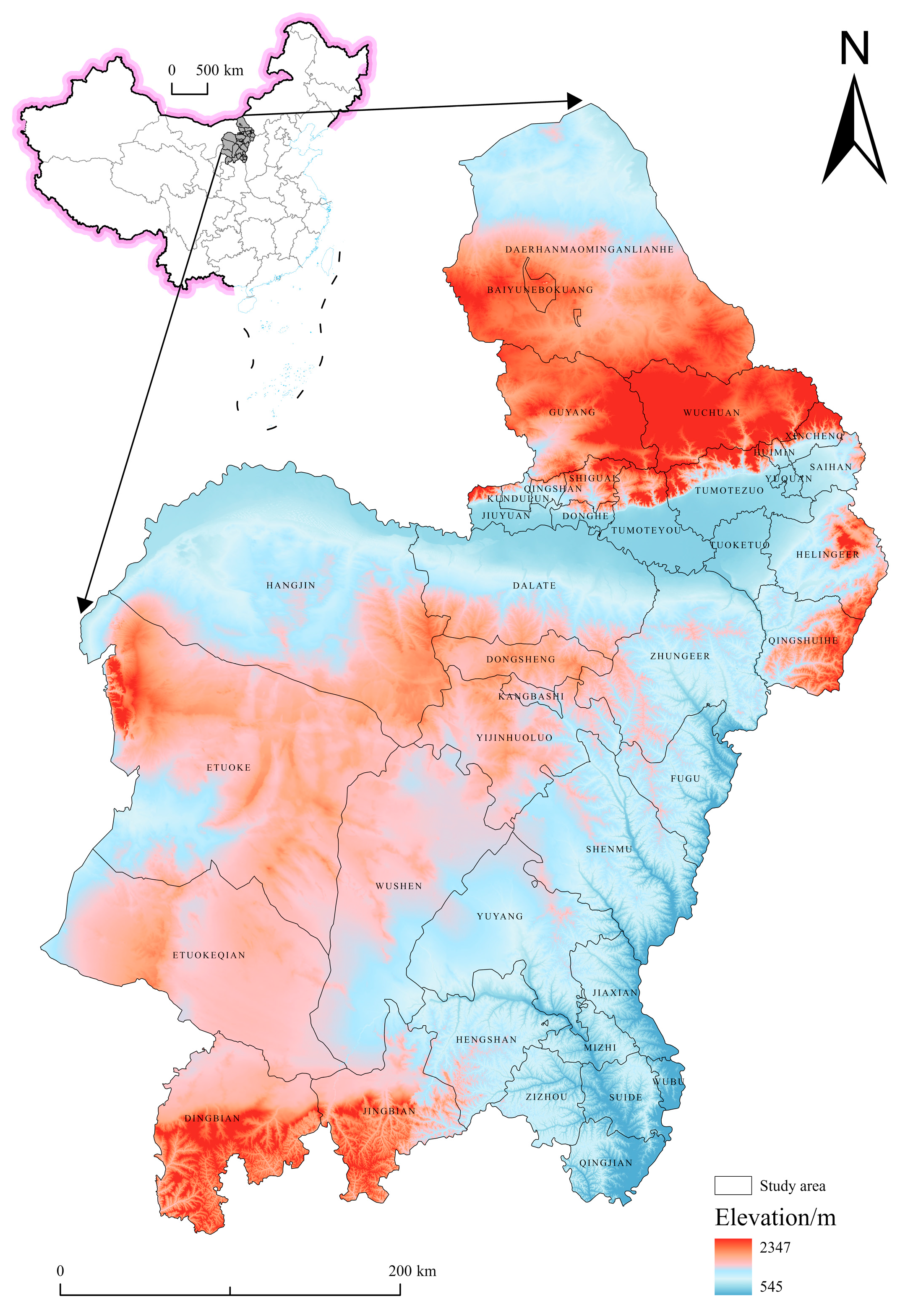
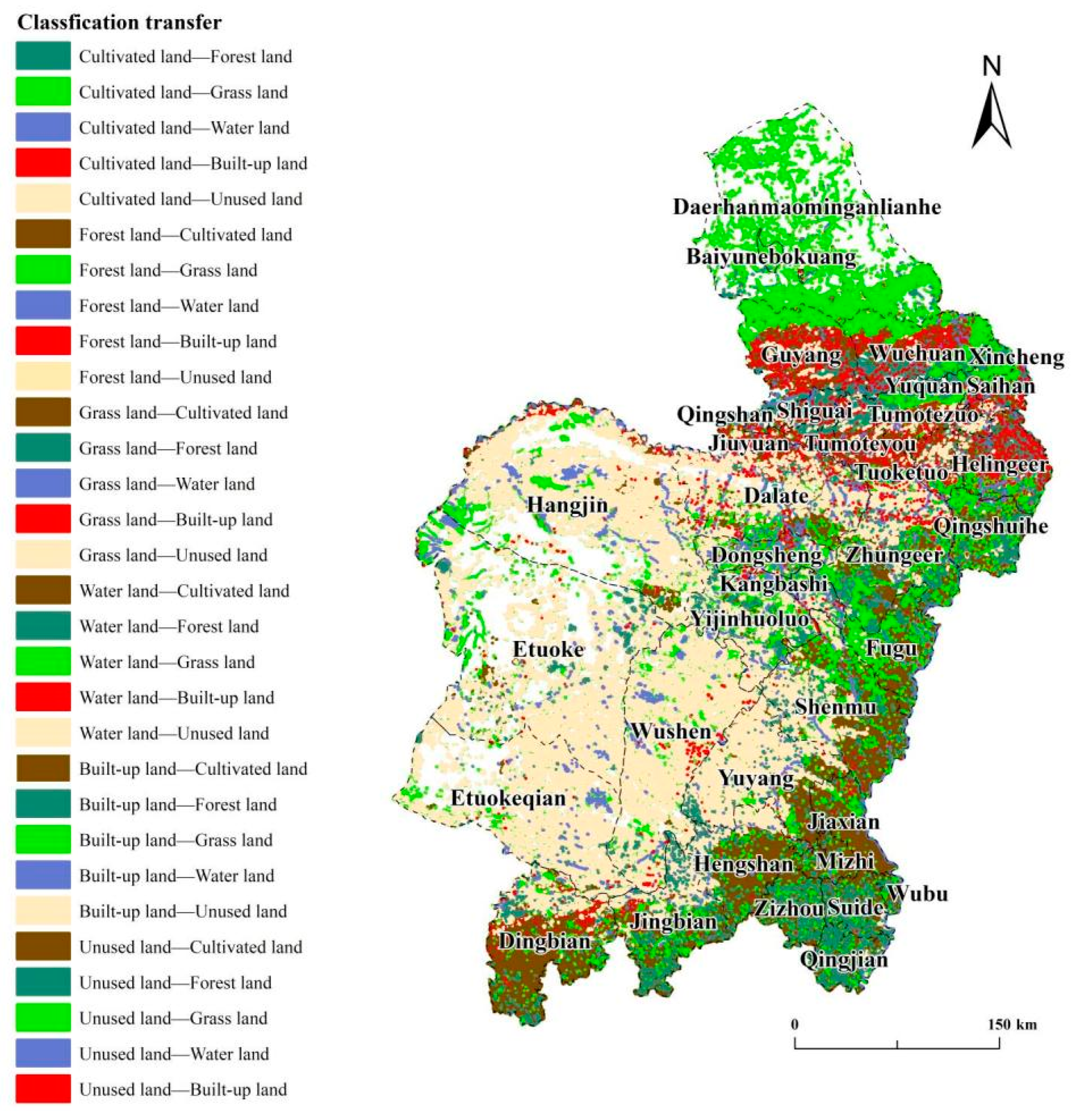
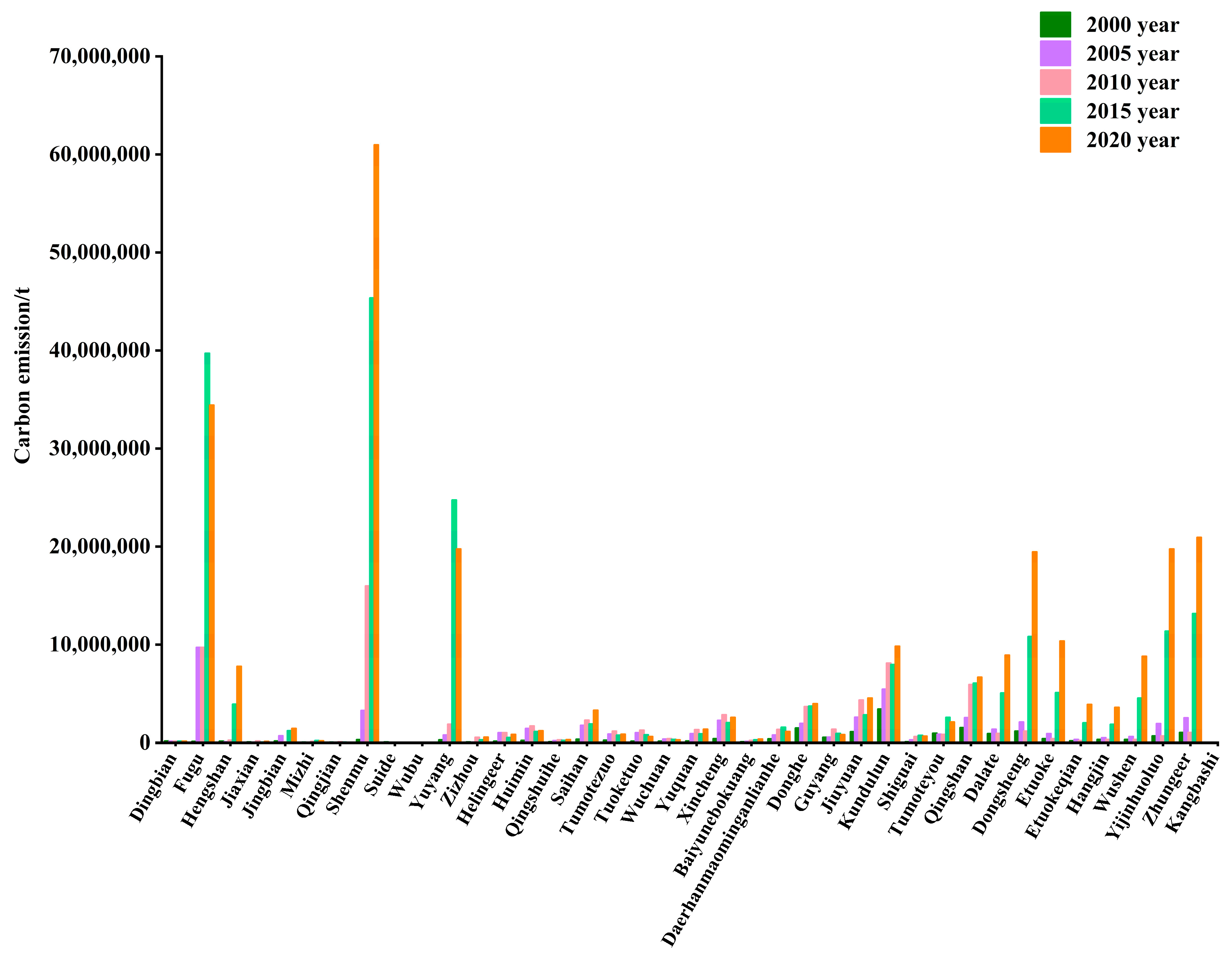
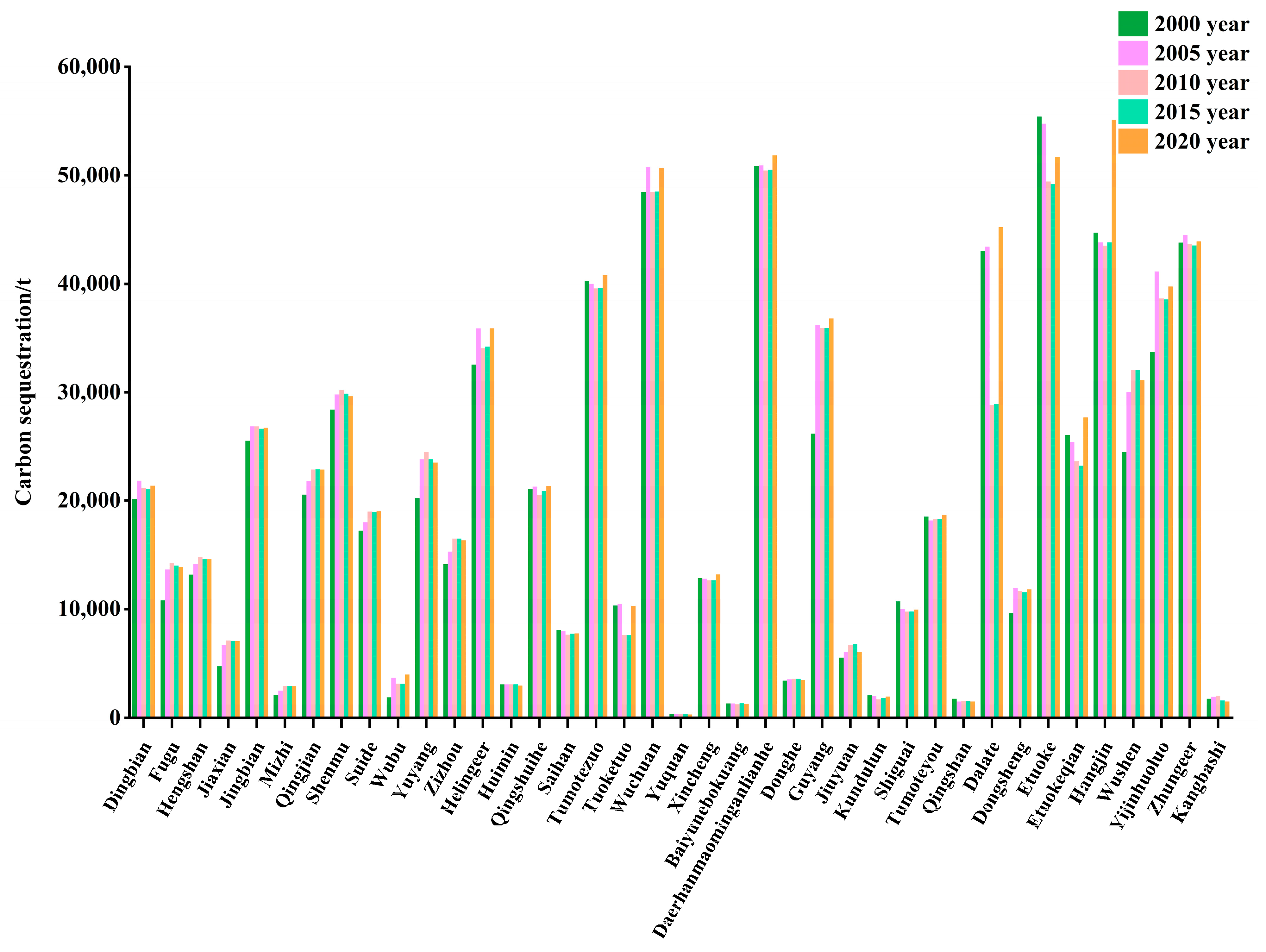
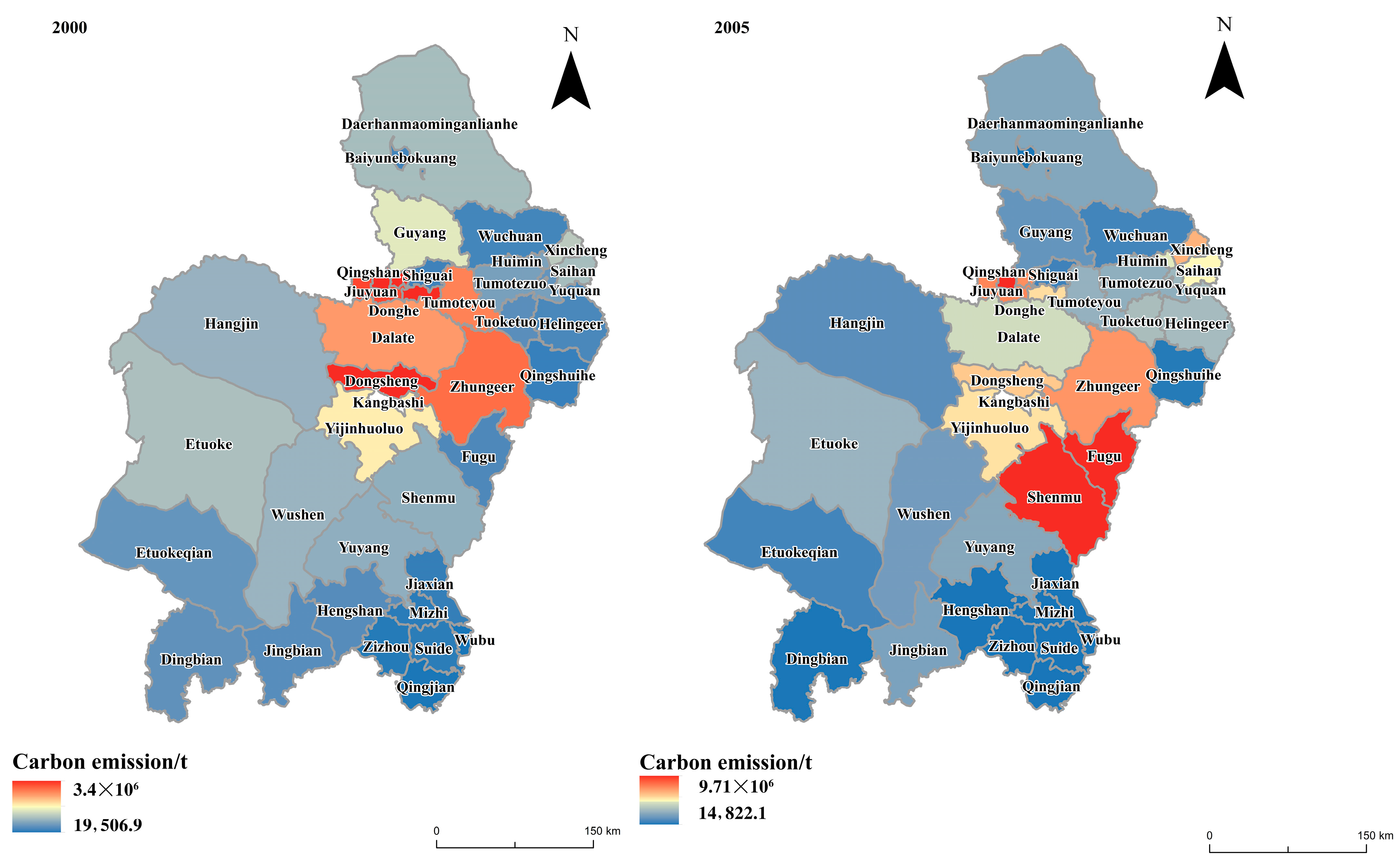
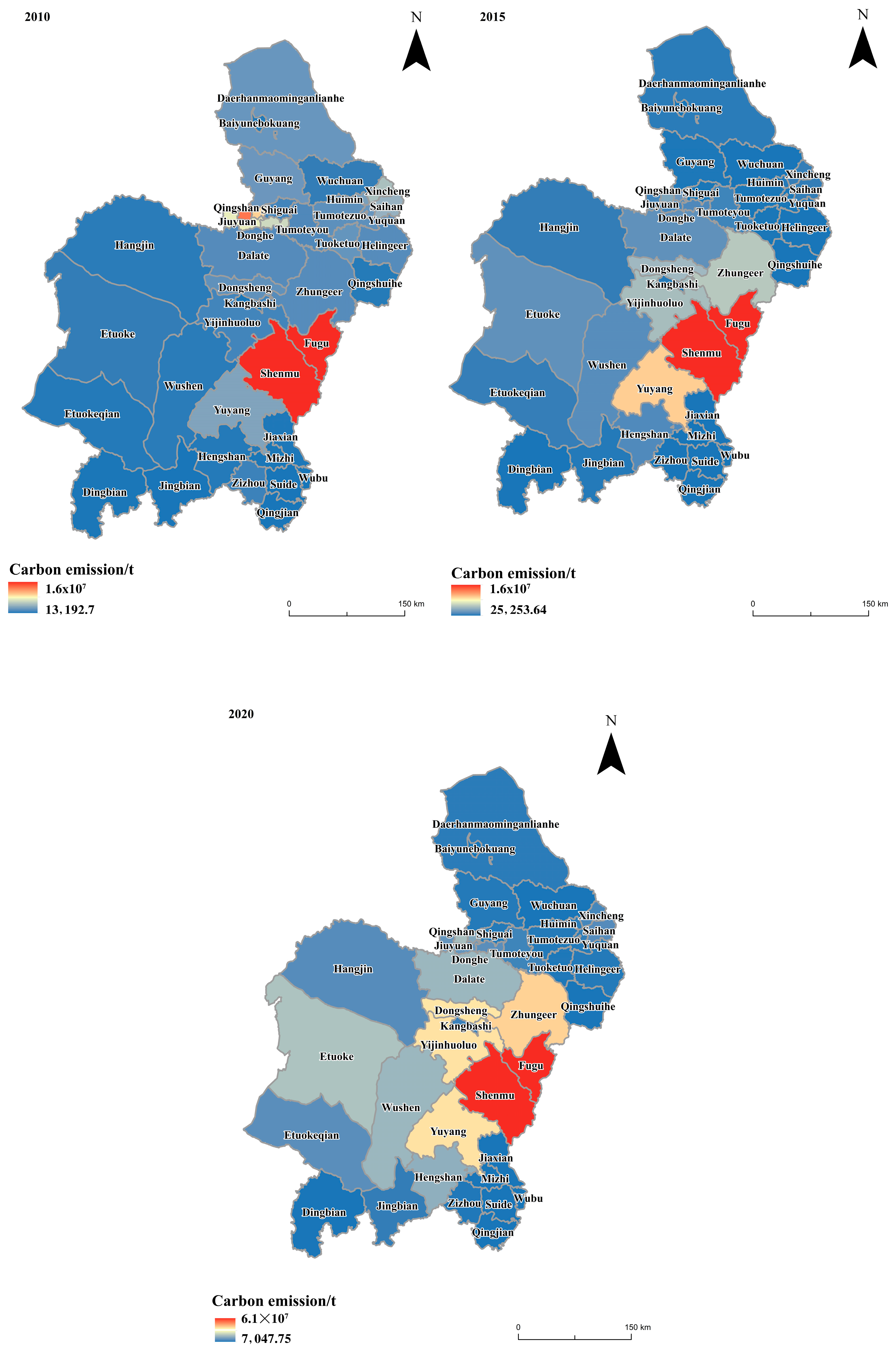
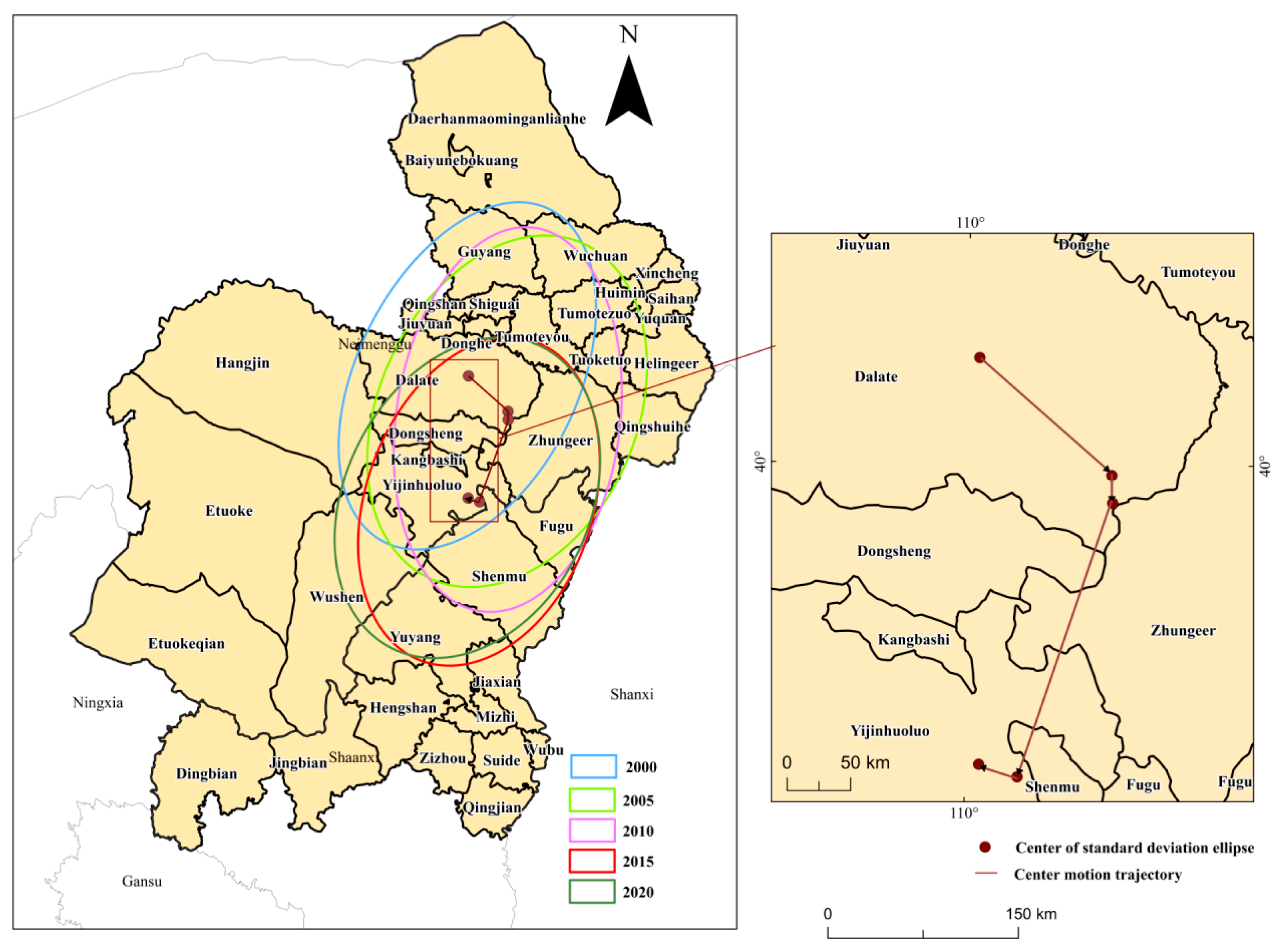
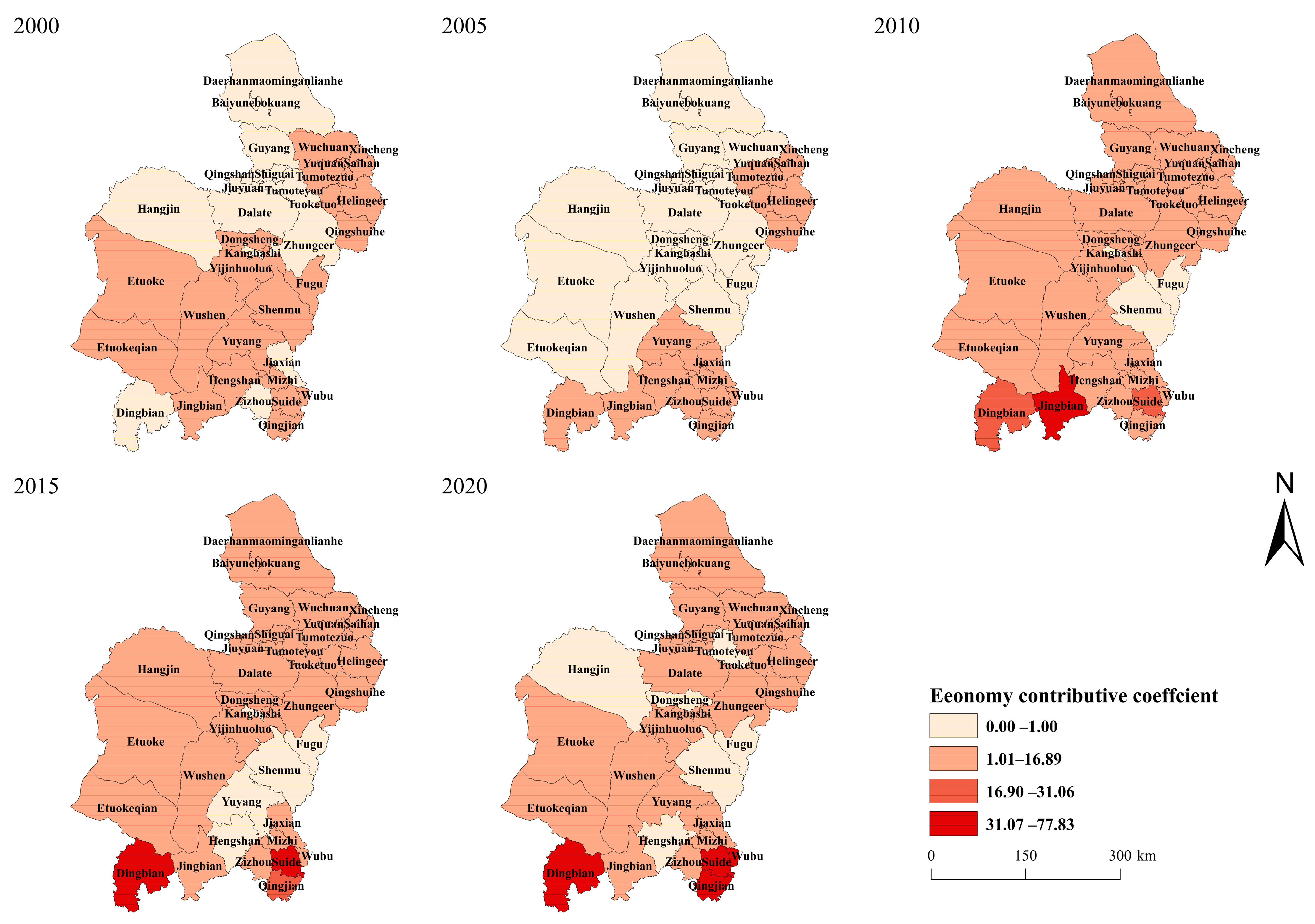
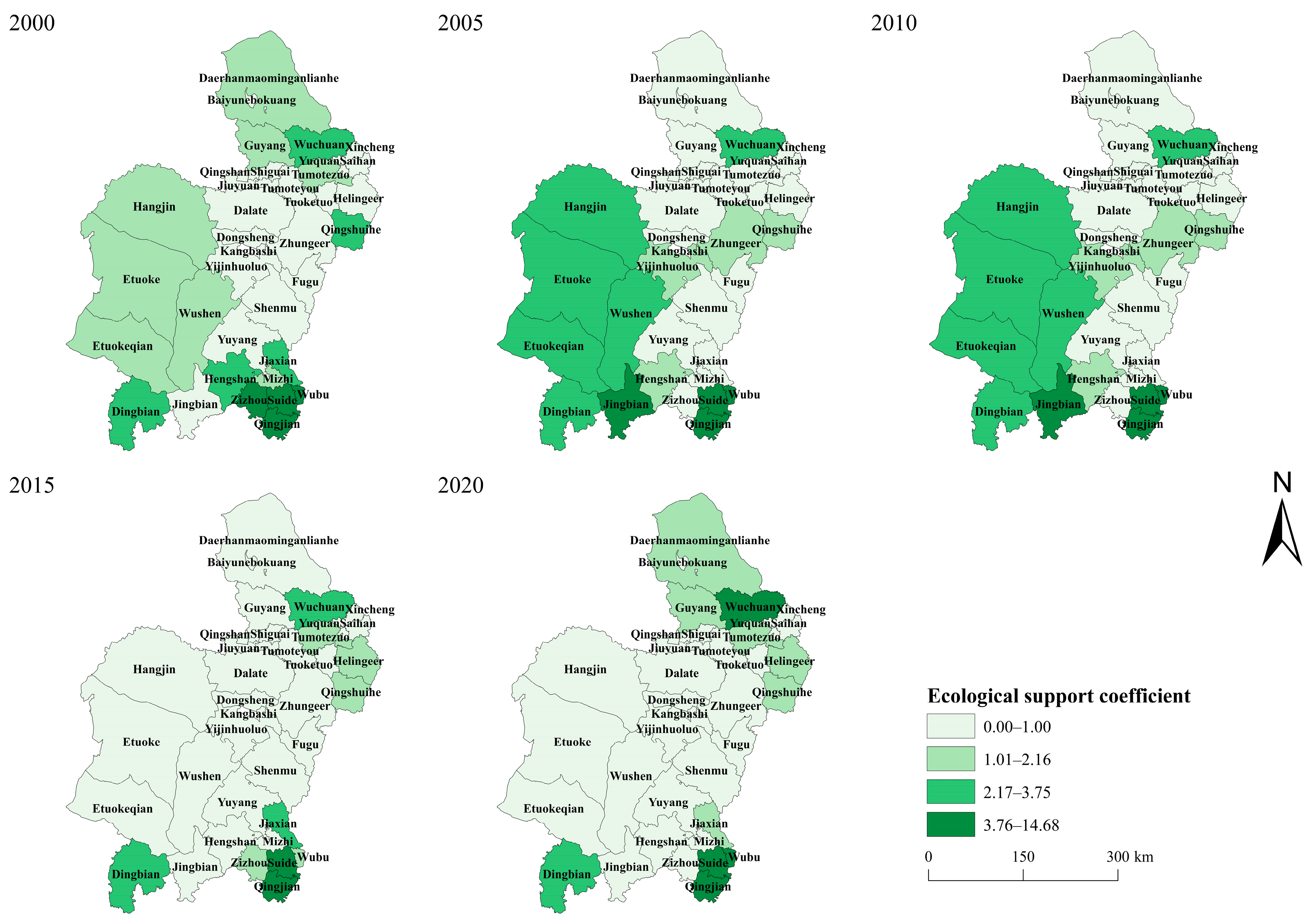

| Land Type | Carbon Emission Factors | Unit | References |
|---|---|---|---|
| Cultivated land | 0.4595 | t/hm2 | Guo et al. [25] |
| Forest land | −0.6125 | t/hm2 | Li et al. [26] |
| Grass land | −0.0215 | t/hm2 | Chen et al. [27] |
| Water land | −0.2523 | t/hm2 | Li et al. [28] |
| Unused land | −0.005 | t/hm2 | Fu et al. [29] |
| Land Use Type | Area Proportion | Attitudes towards Land Use Change Dynamics | |||||||
|---|---|---|---|---|---|---|---|---|---|
| 2000 | 2005 | 2010 | 2015 | 2020 | 2000–2005 | 2005–2010 | 2010–2015 | 2015–2020 | |
| Cultivated land | 18.71 | 18.39 | 18.40 | 18.33 | 17.89 | −0.34 | 0.01 | −0.07 | −0.48 |
| Forest land | 4.20 | 4.70 | 4.44 | 4.43 | 4.84 | 2.37 | −1.08 | −0.05 | 1.84 |
| Grass land | 55.41 | 54.54 | 55.74 | 55.69 | 54.52 | −0.31 | 0.44 | −0.02 | −0.42 |
| Water land | 1.95 | 1.90 | 1.82 | 1.80 | 1.96 | −0.50 | −0.90 | −0.13 | 1.75 |
| Built-up land | 1.54 | 1.69 | 2.21 | 2.39 | 2.96 | 2.06 | 6.14 | 1.62 | 4.70 |
| Unused land | 18.19 | 18.78 | 17.39 | 17.36 | 17.83 | 0.63 | −1.48 | −0.04 | 0.55 |
| 2000 | 2005 | 2010 | 2015 | 2020 | |
|---|---|---|---|---|---|
| Cultivated land | 150.16 | 147.62 | 147.67 | 147.13 | 143.61 |
| Forest land | −44.96 | −50.24 | −47.54 | −47.43 | −51.78 |
| Grass land | −20.81 | −20.48 | −20.94 | −20.92 | −20.48 |
| Water land | −8.59 | −8.38 | −7.99 | −7.95 | −8.64 |
| Built-up land | 1702.86 | 4022.85 | 7178.66 | 20,522.07 | 26,514.10 |
| Unused land | −1.59 | −1.64 | −1.52 | −1.52 | −1.56 |
| Carbon emission | 1853.02 | 4170.47 | 7326.33 | 20,669.20 | 26,657.71 |
| Carbon credits | −75.95 | −80.74 | −77.99 | −77.82 | −82.46 |
| Net carbon emissions | 1777.07 | 4089.73 | 7248.34 | 20,591.38 | 26,575.25 |
| 2000 | 2020 | ||||||
|---|---|---|---|---|---|---|---|
| Cultivated Land | Forest Land | Grass Land | Water Land | Built-Up Land | Unused Land | Accumulation | |
| Cultivated land | _ | −7131.30 | −37,146.54 | −1631.77 | 24,550.53 | −1609.15 | −22,968.23 |
| Forest land | 7129.66 | _ | 6133.74 | 139.56 | 2766.47 | 761.42 | 16,930.85 |
| Grass land | 37,587.57 | −6335.26 | _ | −916.83 | 20,528.69 | 550.89 | 51,415.06 |
| Water land | 1691.90 | −148.16 | −918.90 | _ | 2086.43 | 368.68 | 3079.95 |
| Built-up land | −22,497.47 | −2625.32 | −18,709.63 | −1905.24 | _ | −2833.34 | −48,571.00 |
| Unused land | 1612.79 | −780.81 | −545.27 | −367.94 | 3032.17 | _ | 2950.94 |
| Accumulation | 25,524.45 | −17,020.85 | −51,186.60 | −4682.22 | 52,964.29 | −2761.50 | _ |
| Year | 2000–2005 | 2005–2010 | 2010–2015 | 2015–2020 |
|---|---|---|---|---|
| Displacement/km | 42.52 | 6.65 | 68.40 | 2.81 |
| Year | Area/km2 | Length/km | Center X/(°) | CenterY/(°) | X StdDist/km | Y StdDist/km | Azimuths Angle | Oblateness |
|---|---|---|---|---|---|---|---|---|
| 2000 | 39,928.86 | 744.41 | 110.03 | 40.23 | 86.90 | 146.26 | 26.81 | 0.41 |
| 2005 | 46,074.99 | 779.28 | 110.40 | 39.99 | 101.23 | 144.88 | 24.84 | 0.31 |
| 2010 | 41,986.30 | 768.03 | 110.40 | 39.93 | 87.70 | 152.39 | 8.00 | 0.42 |
| 2015 | 37,314.44 | 705.43 | 110.14 | 39.34 | 89.19 | 133.17 | 19.22 | 0.33 |
| 2020 | 40,044.06 | 722.80 | 110.03 | 39.37 | 96.33 | 132.33 | 26.14 | 0.27 |
| Index | Contribution Value/104 ton | Contribution/% | ||||||
|---|---|---|---|---|---|---|---|---|
| 2000–2005 | 2005–2010 | 2010–2015 | 2015–2020 | 2000–2005 | 2005–2010 | 2010–2015 | 2015–2020 | |
| carbon emissions intensity | 1783.21 | −273.40 | 10,203.16 | −2666.01 | 76.78 | −11.77 | 439.29 | −114.78 |
| Land use structure | 539.44 | 3426.59 | 3140.23 | 8476.51 | 23.22 | 147.53 | 135.20 | 364.95 |
| Land use intensity per unit of GDP | −3416.70 | −6492.35 | −4943.79 | −7154.88 | −147.11 | −279.53 | −212.85 | −308.05 |
| Economic levels | 2970.89 | 6721.52 | 845.86 | 3496.24 | 127.91 | 289.39 | 36.42 | 150.53 |
| Population size | 445.82 | −229.17 | 4097.93 | 3657.94 | 19.19 | −9.87 | 176.44 | 157.49 |
Disclaimer/Publisher’s Note: The statements, opinions and data contained in all publications are solely those of the individual author(s) and contributor(s) and not of MDPI and/or the editor(s). MDPI and/or the editor(s) disclaim responsibility for any injury to people or property resulting from any ideas, methods, instructions or products referred to in the content. |
© 2024 by the authors. Licensee MDPI, Basel, Switzerland. This article is an open access article distributed under the terms and conditions of the Creative Commons Attribution (CC BY) license (https://creativecommons.org/licenses/by/4.0/).
Share and Cite
Chen, Y.; Zhang, C. Characteristics of Spatial–Temporal Evolution of Carbon Emissions from Land Use and Analysis of Influencing Factors in Hubao-Eyu Urban Agglomerations, China. Sustainability 2024, 16, 7565. https://doi.org/10.3390/su16177565
Chen Y, Zhang C. Characteristics of Spatial–Temporal Evolution of Carbon Emissions from Land Use and Analysis of Influencing Factors in Hubao-Eyu Urban Agglomerations, China. Sustainability. 2024; 16(17):7565. https://doi.org/10.3390/su16177565
Chicago/Turabian StyleChen, Yamei, and Chao Zhang. 2024. "Characteristics of Spatial–Temporal Evolution of Carbon Emissions from Land Use and Analysis of Influencing Factors in Hubao-Eyu Urban Agglomerations, China" Sustainability 16, no. 17: 7565. https://doi.org/10.3390/su16177565




